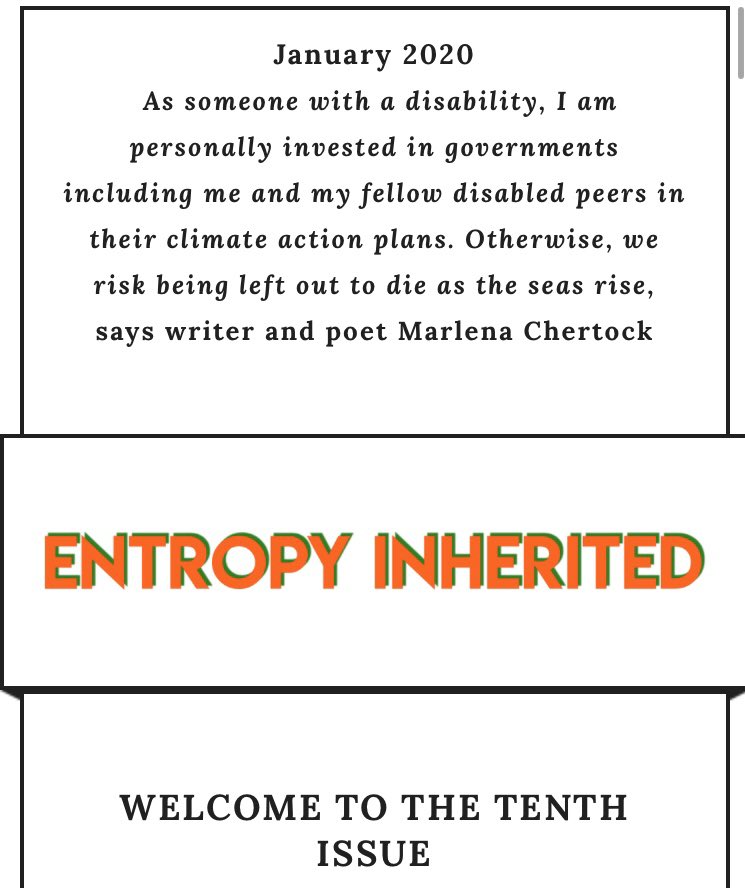This essay first appeared in the Entropy Inherited Newsletter

While this incident turned out to be a gun scare, it didn’t change what in the moment was a very real threat. If it had been a real life or death emergency, I may not have been able to get myself out of the situation. And that terrifies and frustrates me.
Reflecting on this traumatic experience — on how my body responded, and the anxiety that still floods through me — makes me think about how climate change affects people with disabilities. And how little governments, cities, and climate strategies are actually including or considering the disabled in their plans.
Nearly 1 billion people, or 15 percent of the world’s population, are disabled, according to the World Bank. Many people affected by the intensifying impacts of climate change will be disabled. A recent UN resolution calls on governments to “promote and consider their respective obligations on human rights, the right to health, the rights of indigenous peoples, local communities, migrants, children, persons with disabilities and people in vulnerable situations.” The resolution encourages governments to formulate disability-inclusive approaches to address climate change.
Climate change impacts disproportionately affect people with disabilities. Disabled people* may lack the resources to adapt to climate change. They may have various levels of mobility, use mobility devices, have chronic pain, need medical technology such as a stoma bag or medication, and may have mental illness. Disabled people regularly face structural barriers that threaten their lives during disasters, including inaccessible infrastructure and public transportation systems, endemic poverty, limited voice in civic governance, and rigid communications mechanisms. These barriers are inextricably tied to ableism, racism, sexism, and socioeconomic inequity.
Women, indigenous peoples, and youth have been important participants in climate action discussions. It is just as vital to include disabled perspectives when creating and implementing climate action. A variety of people with disabilities should participate in environmental decision-making.
Governments must think carefully about how people with disabilities will be able to access health services, medicine, life-saving technology, electricity, and more during natural disasters and climate change impacts. They must assess the accessibility of current plans and early warning systems; for instance, can people with disabilities access the warnings in multiple formats, do they provide enough time for them to evacuate from impending natural disasters, such as floods or wildfires?
Disability is vast and varied. Even my own bone disorder, spondyloepiphyseal dysplasia, affects people completely differently. It is important for governments to recognize that there are many types of disabilities, that the same disability may not affect everyone similarly, and that all disabilities and illnesses must be considered when creating and implementing climate action. Someone who is D/deaf* will require different accessibility than someone who uses a wheelchair, someone who can walk unassisted but has chronic pain when standing or walking for long periods will likely have other needs than someone who is blind, and someone who uses medical devices that require electricity will likely have different needs than someone with multiple sclerosis.
For more on climate change and disability, I encourage you to listen to this amazing episode on climate change from the Disability Visibility Project, founded by Alice Wong. It highlights the New Earth Disability Initiative from the World Institute on Disability, which analyzes connections between climate change and disability and works to ensure climate adaptation recognizes the needs of people with disabilities.
As someone with a disability, I am personally invested in governments including me and my fellow disabled peers in their climate action plans. Otherwise, we risk being left out to die as the seas rise.
*D/deaf: This term is used by many D/deaf or hard of hearing people. “Deaf” signifies those who use sign language and identify as culturally Deaf and part of the Deaf community, while “deaf” signifies those who are hard of hearing but may use English/spoken language as their first language, may lipread, or may use hearing aids. Read more.
*Disabled versus people with disabilities: Among the disability community, there is an ongoing conversation about identity-first versus people-first language. Some view people-first language (for example, person with a disability) to be the most appropriate way to refer to disabilities, while others view identity-first language (for example, disabled person, D/deaf person) as the most appropriate since disability is such an integral part of people’s experiences. Disabled people should be identified how they want. Read more.